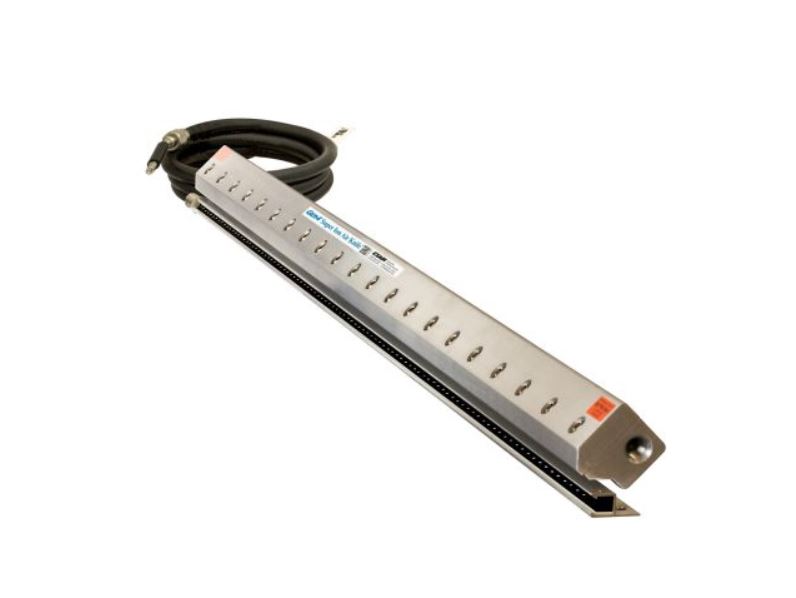Researchers from the University of Jordan have proposed the use of electrostatic cleaning as an effective way to remove dust from solar panels.
Electrostatic cleaning involves the spraying of electrostatically charged mist with low-frequency high voltage onto surfaces and objects. It is commonly used for cleaning and disinfection purposes, and may involve the use of different electrically charging disinfectants, sanitizers, and cleaners.
The scientists said the glass in solar modules contains an equal number of positive and negative charges, which means it is electrically balanced. However, friction might disrupt this balance, causing the material to become electrically charged.
“The electrical charge will create an attraction force between the dust particles and the glass due to static charge causing dust accumulation over PV modules,” the researchers explained.
The academics proposed the use of an electrostatic ionizer, which uses ions to neutralize static electricity, in order to reduce the attraction between dust particles. They used an ionizer manufactured by UK specialist Exair, which could flood the PV module surface with uniform airflow across its length, loaded with static eliminator ions. The ionizer was placed on a shaft 0.2 m the shaft attached to a screw driven by an AC gear motor above the panel.
“The charged surface attracts the appropriate number of positive and negative ions to become neutral,” the researchers explained, noting that this process is able to charge the molecules of the gasses of the surrounding air, which in turn results in a shower of ions. “Stainless steel emitter points inside the Ion Bar receive 5 kVrms high voltage, via an armored and electromagnetic shielded high voltage cable. An integrated ground wire within the power cable creates a discharge path from the emitter to the bar channel.”
The Jordanian group tested the cleaning technique on a set of four 250 W polycrystalline solar modules mounted with a tilt angle of 25 degrees at the renewable energy center of Applied Science Private University in Amman. The performance was compared to that of natural cleaning and cleaning based on anti-reflective coating.
Popular content
After two weeks of testing, the scientists found that the PV modules had an energy yield loss of around 5.93% with natural cleaning. They said that the coating was also about 3.8 times more economically feasible than electrostatic neutralization under the stated conditions in the study.
“However, the vanishing of the coating material after two weeks arising a recoating issue from an economic perspective compared with electrostatic neutralization where the running cost could be eliminated via developing a fixed mechanism with no moving parts,” the scientists said.
The group claims that the performance of the electrostatic cleaning technique could be further improved by enhancing its intrinsice mechanism.
“Even though nano-coating seems economic wiser than electrostatic cleaning, electrostatic cleaning has promising future for mega solar power plants in arid regions by advantage of less affecting by harsh outside conditions which require frequent coating, and the potential to develop a practical mechanism for electrostatic cleaning with less capital and running costs,” they said.
The scientists published their findings in “Electrostatic cleaning effect on the performance of PV modules in Jordan,” which was recently published in Cleaner Engineering and Technology. In March, scientists from the Massachusetts Institute of Technology have developed a lab-scale solar module cleaning system prototype that uses electrostatic repulsion to cause dust particles to detach and virtually leap off the surface of panels.
This content is protected by copyright and may not be reused. If you want to cooperate with us and would like to reuse some of our content, please contact: editors@pv-magazine.com.



1 comment
By submitting this form you agree to pv magazine using your data for the purposes of publishing your comment.
Your personal data will only be disclosed or otherwise transmitted to third parties for the purposes of spam filtering or if this is necessary for technical maintenance of the website. Any other transfer to third parties will not take place unless this is justified on the basis of applicable data protection regulations or if pv magazine is legally obliged to do so.
You may revoke this consent at any time with effect for the future, in which case your personal data will be deleted immediately. Otherwise, your data will be deleted if pv magazine has processed your request or the purpose of data storage is fulfilled.
Further information on data privacy can be found in our Data Protection Policy.